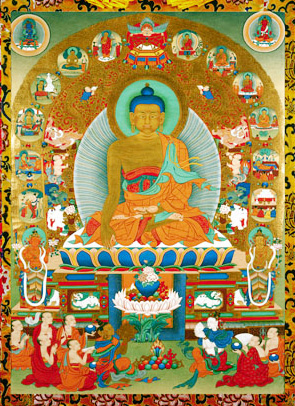Twelve deeds: Difference between revisions
Jump to navigation
Jump to search
No edit summary |
mNo edit summary |
||
| (13 intermediate revisions by 4 users not shown) | |||
| Line 1: | Line 1: | ||
[[Image:Buddha12deeds.jpg|frame|'''The Twelve Deeds of the Buddha''']] | [[Image:Buddha12deeds.jpg|frame|'''The Twelve Deeds of the Buddha''']] | ||
''' | The '''twelve deeds''' (Skt. ''dvadaśabuddhakārya''; Tib. མཛད་པ་བཅུ་གཉིས་, ''dzepa chunyi'', [[Wyl.]] ''mdzad pa bcu gnyis'') carried out by a [[nirmanakaya|supreme nirmanakaya]] [[buddha]], such as the [[Buddha Shakyamuni]], are: | ||
#the descent from [[Tushita]], the Joyous pure land (''dga' ldan gyi gnas nas 'pho ba''), | #the descent from [[Tushita]], the Joyous pure land (''dga' ldan gyi gnas nas 'pho ba''), | ||
#entering the mother’s womb (''lhums su zhugs pa''), | #entering the mother’s womb (''lhums su zhugs pa''), | ||
#taking birth in the [[Lumbini]] garden (''sku bltams pa''), | #taking birth<ref>In the case of Buddha Shakyamuni, this was in the [[Lumbini]] garden.</ref> (''sku bltams pa''), | ||
#becoming skilled in various arts (''bzo yi gnas la mkhas pa''), | #becoming skilled in various arts (''bzo yi gnas la mkhas pa''), | ||
#delighting in the company of royal consorts (''btsun mo'i 'khor dgyes rol ba''), | #delighting in the company of royal consorts (''btsun mo'i 'khor dgyes rol ba''), | ||
| Line 10: | Line 10: | ||
#proceeding to the foot of the [[bodhi tree]] (''byang chub snying por gshegs pa''), | #proceeding to the foot of the [[bodhi tree]] (''byang chub snying por gshegs pa''), | ||
#overcoming [[Mara]]’s hosts (''bdud btul ba''), | #overcoming [[Mara]]’s hosts (''bdud btul ba''), | ||
#becoming fully enlightened (''mngon par rdzogs par sangs rgyas pa''), | #becoming fully [[enlightenment|enlightened]] (''mngon par rdzogs par sangs rgyas pa''), | ||
#turning the wheel of [[Dharma]] (''chos kyi 'khor lo bskor ba''), and | #turning the wheel of [[Dharma]] (''chos kyi 'khor lo bskor ba''), and | ||
#passing into [[parinirvana|mahaparinirvana]] in the city of [[Kushinagara]] (''mya ngan las 'das pa'') | #passing into [[parinirvana|mahaparinirvana]] <ref>In the case of Buddha Shakyamuni, this was in the city of [[Kushinagara]].</ref> (''mya ngan las 'das pa'') | ||
==Alternative Lists== | |||
*The description of Buddha's life in twelve deeds appeared later, in the first centuries of the common era within [[Mahayana]] sources. The [[Theravadin]] tradition lists only eight deeds: | |||
#the descent from Tushita, | |||
#entering the mother’s womb, | |||
#taking birth, | |||
#leaving his family, | |||
#overcoming Mara, | |||
#turning the wheel of [[Dharma]] and | |||
#passing into [[nirvana]] or [[parinirvana]].<ref>Philippe Cornu, ''Manuel de bouddhisme — Philosophie, pratique et histoire. Tome I, Bouddhisme ancien et Theravāda'' (Editions Rangdröl, 2019), page 39.</ref> | |||
==Alternative Translations== | |||
*Twelve Acts [of the Buddha] | |||
==Notes== | |||
<small><references/></small> | |||
==Teachings Given to the [[About Rigpa|Rigpa]] Sangha== | |||
*[[Dzogchen Rinpoche]], [[Lerab Ling]], 6-7 June 1998 | |||
==Further Reading== | ==Further Reading== | ||
*Lobsang Dhargyay, 'The Twelve Deeds of the | *Lobsang Dhargyay, 'The Twelve Deeds of the Buddha—A Controversial Hymn ascribed to Nagarjuna' in ''The Tibet Journal'', Vol.IX, No.2, Summer 1984 | ||
*[[Philippe Cornu]], ''Manuel de bouddhisme — Philosophie, pratique et histoire. Tome I, Bouddhisme ancien et Theravāda'' (Editions Rangdröl, 2019), pages 37-58. | |||
==External Links== | |||
*{{LH|tibetan-masters/jigme-lingpa/praise-twelve-acts-buddha|''Praise of the Twelve Acts of the Buddha''}} by [[Jigme Lingpa]] | |||
*[[:Category:Life of the Buddha|Tibetan terms related to the life of the Buddha]] | |||
[[Category:Buddha Shakyamuni]] | |||
[[Category:The Twelve Deeds]] | |||
[[Category:Enumerations]] | [[Category:Enumerations]] | ||
[[Category:12-Twelve]] | |||
Latest revision as of 10:32, 15 October 2021

The twelve deeds (Skt. dvadaśabuddhakārya; Tib. མཛད་པ་བཅུ་གཉིས་, dzepa chunyi, Wyl. mdzad pa bcu gnyis) carried out by a supreme nirmanakaya buddha, such as the Buddha Shakyamuni, are:
- the descent from Tushita, the Joyous pure land (dga' ldan gyi gnas nas 'pho ba),
- entering the mother’s womb (lhums su zhugs pa),
- taking birth[1] (sku bltams pa),
- becoming skilled in various arts (bzo yi gnas la mkhas pa),
- delighting in the company of royal consorts (btsun mo'i 'khor dgyes rol ba),
- developing renunciation and becoming ordained (rab tu byung ba),
- practicing austerities for six years (dka' ba spyad pa),
- proceeding to the foot of the bodhi tree (byang chub snying por gshegs pa),
- overcoming Mara’s hosts (bdud btul ba),
- becoming fully enlightened (mngon par rdzogs par sangs rgyas pa),
- turning the wheel of Dharma (chos kyi 'khor lo bskor ba), and
- passing into mahaparinirvana [2] (mya ngan las 'das pa)
Alternative Lists
- The description of Buddha's life in twelve deeds appeared later, in the first centuries of the common era within Mahayana sources. The Theravadin tradition lists only eight deeds:
- the descent from Tushita,
- entering the mother’s womb,
- taking birth,
- leaving his family,
- overcoming Mara,
- turning the wheel of Dharma and
- passing into nirvana or parinirvana.[3]
Alternative Translations
- Twelve Acts [of the Buddha]
Notes
- ↑ In the case of Buddha Shakyamuni, this was in the Lumbini garden.
- ↑ In the case of Buddha Shakyamuni, this was in the city of Kushinagara.
- ↑ Philippe Cornu, Manuel de bouddhisme — Philosophie, pratique et histoire. Tome I, Bouddhisme ancien et Theravāda (Editions Rangdröl, 2019), page 39.
Teachings Given to the Rigpa Sangha
- Dzogchen Rinpoche, Lerab Ling, 6-7 June 1998
Further Reading
- Lobsang Dhargyay, 'The Twelve Deeds of the Buddha—A Controversial Hymn ascribed to Nagarjuna' in The Tibet Journal, Vol.IX, No.2, Summer 1984
- Philippe Cornu, Manuel de bouddhisme — Philosophie, pratique et histoire. Tome I, Bouddhisme ancien et Theravāda (Editions Rangdröl, 2019), pages 37-58.